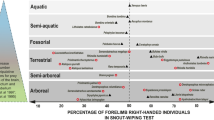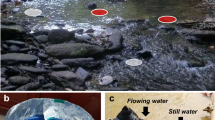Summary
- 1.
Mictyris platycheles, the soldier crab, walks predominantly forward (Fig. 2). Two-thirds of the crabs studied used all 10 legs in walking; the remainder held up the chelae and walked with 8 legs.
- 2.
The soldier crab is egg-shaped in contrast to laterally elongated sideways-walking crabs. Its joints which allow anterior-posterior leg movement describe larger angles than in sideways-walking crabs of a similar size, while its joints which permit lateral movement describe smaller angles (Fig. 1).
- 3.
Mictyris walks mainly with two gaits: one overlapping (2534 or equivalents; >50% of the time) and the other metachronal (2345 or equivalents; >30% of the time) (Tables 1 and 2). It uses both at all but the highest stepping frequencies at which the overlapping gait predominates (Fig. 5).
- 4.
Crabs stepped between 2 and 4 steps/s. With increasing rate the durations of both power and return strokes, which are nearly equal in each leg except leg 1, decreased (Fig. 7).
- 5.
Ipsilateral legs 1 and 4 in 10-legged crabs and ipsilateral legs 2 and 5 in all crabs tended to step together (Fig. 8). Adjacent legs on the same side of the body stepped neither in phase nor in antiphase but with a mean phase relationship of 0.33. Contralateral legs of the same segment stepped nearly in opposite phase (Fig. 6 and Table 3).
- 6.
The stepping pattern (Figs. 3, 4 and 9) is generated by alternation at one-sixth of a step cycle between sets of one or two legs on opposite sides of the body. At any given moment during walking crabs support themselves by various numbers of legs.
- 7.
To walk forwardMictyris uses strategies of promotion and remotion similar to those employed by long-bodied decapod crustaceans. It also uses the same gaits and phase relationships on both sides of the body. In these respects the walk ofMictyris more nearly resembles those of other forward-walking animals rather than sideways-walking crabs.
Similar content being viewed by others
References
Alexander, C.G.: Locomotion in the isopod crustacean.Ligia oceanica (Linn.). Comp. Biochem. Physiol.42A, 1039–1047 (1972)
Ayers, J., Clarac, F.: Neuromuscular strategies underlying different behavioral acts in a multifunctional crustacean leg joint. J. Comp. Physiol.128A, 81–94 (1978)
Ayers, J.L., Davis, W.J.: Neuronal control of locomotion in the lobster,Homarus americanus. I. Motor programs for forward and backward walking. J. Comp. Physiol.115, 1–27 (1977)
Barnes, W.J.P.: Leg co-ordination during walking in the crab,Uca pugnax. J. Comp. Physiol.96, 237–256 (1975)
Bethe, A.: Das Nervensystem vonCarcinus maenas. Ein anatomisch-physiologischer Versuch. 1. Theil. I. Mittheilung. Arch. Mikroskop. Anat. Entwicklungsmech.50, 460–546 (1897)
Bethe, A.: Studien über die Plastizität des Nervensystems. I. Mitteilung: Arachnoideen und Crustaceen. Pflügers Arch.224, 793–820 (1930)
Bowerman, R.F.: The control of walking in the scorpion. I. Leg movements during normal walking. J. Comp. Physiol.100, 183–196 (1975)
Bowerman, R.F.: The control of arthropod walking. Comp. Biochem. Physiol.56A, 231–247 (1977)
Burns, M.D.: The control of walking in orthoptera. I. Leg movements in normal walking. J. Exp. Biol.58, 45–58 (1973)
Burrows, M., Hoyle, G.: The mechanism of rapid running in the ghost crab,Ocypode ceratophthalma. J. Exp. Biol.58, 327–349 (1973)
Clarac, F., Ayers, J.: La marche chez les crustacés: activité motrice programèe et regulation peripherique. J. Physiol. (Paris)73, 523–544 (1977)
Clarac, F., Chasserat, C.: Experimental modification of interlimb coordination during locomotion of a crustacean. Neurosci. Lett.12, 271–276 (1979)
Clarac, F., Coulmance, M.: La marche latérale du crabe (Carcinus). Coordination des mouvements articulaires et régulation proprioceptive. Z. Vergl. Physiol.73, 408–438 (1971)
Dakin, W.J.: Australian Seashores. Sydney: Angus and Robertson 1952
Delcomyn, F.: The locomotion of the cockroachPeriplaneta americana. J. Exp. Biol.54, 443–452 (1971)
Evoy, W.H., Fourtner, C.R.: Crustacean walking. In: Control of posture and locomotion. Stein, R.B., Pearson, K.G., Smith, R.S., Redford, J.B. (eds.), pp. 477–493. New York: Plenum Press 1973
Glaessner, M.F.: Decapoda. In: Treatise on invertebrate paleontology. Part R: Arthropoda 4, Vol. 2. Moore, R.G. (ed.), pp. R400-R566. Lawrence: University of Kansas and Geological Society of America 1969
Graham, D.: A behavioural analysis of the temporal organisation of walking movements in the 1st instar and adult stick insect (Carausius morosus). J. Comp. Physiol.81, 23–52 (1972)
Grecian, E.A.: Ecology and physiology ofMictyris platycheles. Honors thesis, University of Tasmania, Hobart (1973)
Grillner, S.: Locomotion in vertebrates: central mechanisms and reflex interaction. Physiol. Rev.55, 247–304 (1975)
Hoyle, G.: Arthropod walking. In: Neural control of locomotion. Herman, R.M., Grillner, S., Stein, P.S.G., Stuart, D.G. (eds.), pp. 137–179. New York: Plenum Press 1976
Macmillan, D.L.: A physiological analysis of walking in the American lobster (Hormarus americanus). Phil. Trans. R. Soc. (Biol.)270, 1–59 (1975a)
Macmillan, D.L., Silvey, G.E., Wilson, I.S.: Co-ordination of the movements of the appendages in the Tasmanian Mountain ShrimpAnaspides tasmaniae. Phil. Trans. R. Soc. (Biol.) (in press) (1980)
Manton, S.M.: The evolution of arthropodan locomotory mechanisms — Part 2. General introduction to the locomotory mechanisms of the arthropoda. J. Linn. Soc. Zool.42, 93–117 (1952)
Manton, S.M.: The Arthropoda, pp. 309–314. Oxford: Clarendon Press 1977
Sleinis, S.: A study of locomotion ofMictyris platycheles. Honors thesis, University of Tasmania (1977)
Spirito, C.P., Mushrush, D.L.: Interlimb coordination during slow walking in the cockroach. I. Effects of substrate alterations. J. Exp. Biol.78, 233–243 (1979)
Wilson, D.M.: Insect walking. Annu. Rev. Entomol.11, 103–122 (1966)
Wilson, D.M.: Stepping patterns in tarantula spiders. J. Exp. Biol.47, 133–151 (1967)
Author information
Authors and Affiliations
Additional information
We are grateful to Othmar Buchmann, Mark Leggett and David Macmillan for critical readings of the manuscript, to Helen LaMer for typing, and to Bill Wilson.
Rights and permissions
About this article
Cite this article
Sleinis, S., Silvey, G.E. Locomotion in a forward walking crab. J. Comp. Physiol. 136, 301–312 (1980). https://doi.org/10.1007/BF00657350
Accepted:
Issue Date:
DOI: https://doi.org/10.1007/BF00657350




